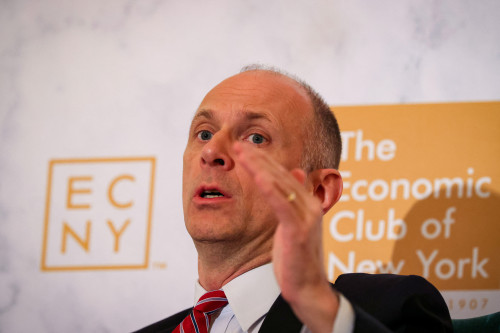By Howard Schneider and Ann Saphir
WASHINGTON (Reuters) -The U.S. is “no longer an overheated economy” with a job market that has “cooled considerably” from its pandemic-era extremes and in many ways is back where it was before the health crisis, Fed Chair Jerome Powell said in remarks to Congress that suggested the case for interest rate cuts is becoming stronger.
“We are well aware that we now face two-sided risks,” and can no longer focus solely on inflation that nevertheless still “remains above” the central bank’s 2% target, Powell told the Senate Banking committee on Tuesday. “The labor market appears to be fully back in balance.”
Powell in his prepared remarks told Senators that inflation had been improving in recent months and that “more good data would strengthen” the case for looser monetary policy.
The Fed has kept its policy rate in the 5.25% to 5.5% range since July of 2023.
Powell’s comments appeared to show increasing faith that inflation will return to the Fed’s target, and contrasted the lack of progress on inflation in the first months of the year to recent improvement that has helped build the Fed’s confidence that price pressures will continue to diminish.
“After a lack of progress toward our 2% inflation objective in the early part of this year, the most recent monthly readings have shown modest further progress,” Powell said in remarks to the Senate Banking Committee. “More good data would strengthen our confidence that inflation is moving sustainably toward 2%.”
The Fed receives consumer price information for the month of June on Thursday.
A jobs report on Friday showed a still-solid 206,000 jobs added in June, but with a slowing monthly trend and a rising unemployment rate now at 4.1%.
Powell called that a “still low level,” but also noted that “in light of the progress made both in lowering inflation and in cooling the labor market over the past two years, elevated inflation is not the only risk we face.”Leaving policy too tight for too long, “could unduly weaken economic activity and employment,” Powell said, undermining a period of economic growth that he said “remains solid” with “robust” private demand, improved overall supply conditions, and a “a pickup in residential investment.”
Powell’s comments may firm expectations for changes to the policy statement to be released after the Fed’s July 30-31 meeting that at least open the door to a September rate cut now given a roughly 70% probability by investors – barring a surprise jump in coming inflation readings.
“He’s beginning to tee up a rate cut,” said Brian Jacobsen, chief economist with Annex Wealth Management in Brookfield Wisconsin. “They view risks in not cutting soon enough. It used to be that they were singularly focus on inflation.”
At the Fed’s June 11-12 meeting the median projection of 19 officials was for just a single quarter-point rate cut by the end of the year, but since then inflation data has come in weaker than expected.
The consumer price index did not rise at all in May, and analysts anticipate another weak reading when new data is released on Thursday.
Powell’s testimony is his latest in a semiannual round of hearings on monetary policy, with questions from Senators following his remarks. He will appear before the House Financial Services Committee on Wednesday at 10 a.m. EDT (1400 GMT).
The congressional hearings also typically see Powell questioned on a broad array of topics, and that grilling could be more intense ahead of a November presidential election in which the Fed’s decision to either move forward with or postpone rate cuts is likely to become part of the debate.
The inflation target is set in reference to the Personal Consumption Expenditures price index, which as of May was increasing at a 2.6% year-over-year rate.
That is down from its pandemic-era peak, but the inflation shock remains a potent political debating point.
In a report to Congress released on Friday ahead of Powell’s testimony, the Fed noted that there was good reason to believe that price pressures, particularly in the housing market, a significant contributor to inflation’s recent persistence, were in decline.
Combined with concerns about the job market, that should “leave the Fed fretting more about the risk of recession than of sticky inflation,” economists at Pantheon Macroeconomics wrote after the last jobs report.
(Reporting by Howard Schneider; Additional reporting by Sinead Carew; Editing by Andrea Ricci)



